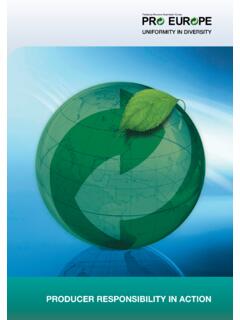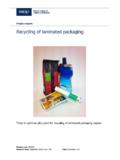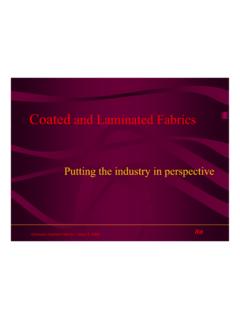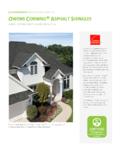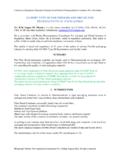Transcription of Participation Costs Overview 2017 - pro-e.org
1 Published by PRO Europe Status: February 2017 Contact: ok Participation Costs Overview 2017 2 Table of content FOREWORD .. 3 AUSTRIA - ARA ALTSTOFF recycling AUSTRIA AG .. 4 BELGIUM - FOST PLUS .. 6 FEDERATION OF BOSNIA AND HERZEGOVINA EKOPAK .. 9 BULGARIA ECOPACK BULGARIA .. 11 CROATIA EKO-OZRA 2017 .. 13 CYPRUS - GREEN DOT .. 14 CZECH REPUBLIC - EKO-KOM .. 15 ESTONIA ETO-2016 .. 16 FRANCE ECO-EMBALLAGES .. 17 GERMANY - DER GR NE PUNKT - DUALES SYSTEM DEUTSCHLAND GMBH (DSD) .. 18 GREECE - .. 19 HUNGARY KOPANNON .. 20 IRELAND - REPAK 2017 .. 23 ISRAEL TAMIR .. 24 LATVIA - LATVIJAS ZA AIS PUNKTS, JSC .. 25 LITHUANIA - V " ALIASIS TA KAS" .. 26 LUXEMBOURG - VALORLUX .. 27 MACEDONIA - PAKOMAK SKOPJE (2017) .. 28 MALTA - GREENPAK .. 29 THE NETHERLANDS AFVALFONDS VERPAKKINGEN .. 30 NORWAY - GR NT PUNKT .. 31 POLAND - REKOPOL .. 33 PORTUGAL - SOCIEDADE PONTO VERDE.
2 34 ROMANIA - ECO-ROM AMBALAJE .. 35 SERBIA - SEKOPAK .. 36 SLOVAKIA - ENVI-PAK .. 37 SLOVENIA - SLOPAK .. 38 SPAIN - ECOEMBES .. 39 SWEDEN FTI .. 41 TURKEY CEVKO .. 42 UNITED KINGDOM VALPAK .. 43 3 Foreword International comparisons and benchmarking of European packaging recovery systems is a complex issue very often such efforts result in comparing apples with oranges or worse. There are several factors affecting fee levels which should be taken into account when comparing the relative Costs of compliance across various European schemes. Major factors influencing relative compliance Costs include the following: Existing national collection and recovery infrastructure in the waste management sector both for packaging waste as well as other waste streams residual and organic waste. The source of packaging used to meet national recycling quotas (household only or all packaging , including industrial and transport packaging ).
3 Household packaging waste is more expensive to collect and recover than packaging waste arising at production or retail outlets. The proportionate share of Costs which industry bears: Some schemes meet 100% cost of collection and recovery cost, while others only pay a share thereof, and the rest is paid by the municipalities/fees from consumers. National recycling targets and the effect of derogations for some member states. Collection system used - bring systems are generally less expensive than kerbside collection from households. Geographic location and population density - Remote and sparsely populated regions will generally be more difficult and expensive to collect from. Enforcement influences Costs : The more companies participate in the scheme and the lower the rate of freeriders, the greater the spread of the cost base, and the lower the cost for the individual company.
4 Labour Costs and general overheads differ depending on the prevailing local economic conditions. National waste legislation and enforcement: some countries have a comprehensive landfill ban in effect, while others still are striving to manage largely unstructured waste disposal. The present document provides an Overview about the Costs of Participation in the respective national recovery systems for packaging and packaging waste for 2017 (where available). All figures have been sent to us by the respective systems and have been compiled to the best of our knowledge. Nevertheless, this information is subject to change without prior notice to us and we therefore cannot guarantee its accuracy and applicability to each packaging . We therefore kindly ask you to get in touch with the respective system(s) of your country(ies) of operation to obtain the latest information relevant to you.
5 Should you have any further questions, please feel free to contact me. Best regards,Ursula Denison, Managing Director of PRO Europe 4 Austria - ARA Altstoff recycling Austria AG packaging materials on a biological basis Definition of packaging materials on a biological basis: packaging materials on a biological basis (also biogenic packaging materials , biogenic packaging , bio plastics , biodegradable materials ) within the meaning of the packaging Ordinance are materials made of renewable raw materials, which are used for packaging purposes and which are biodegradable. Furthermore they cannot be assigned to the tariff categories to listed on 5 the previous page. packaging materials on a biological basis are for example: Starch, starch blend, and biotechnologically produced polymers such as poly lactic acid (PLA). Pricing model for packaging waste of categories , and that is recovered through commercial systems For certain types of packaging , ARA license partners may use commercial tariffs instead of standard tariffs in the calculation of their quantity-based license fees, provided they can furnish adequate documentation that these waste arisings were recovered through a commercial collection system.
6 Adequate documentation means transparent and plausible data, like sales data, customer structure or sales statistics. This pricing model applies to sales packaging paper (category ), ferrous metal small ( ) and plastics small ( ); the commercial tariffs to be used instead are for transport packaging paper ( ), ferrous metal large ( ) and industrial, commercial and large plastic packaging ( and ), respectively. packaging waste generated in companies and organisations with household-like packaging waste arisings has to be allocated to the household systems. ARA s commercial tariffs are not applicable in such cases. Please find further definitions of packaging types in the Informations- und Merkbl tter , which you may order from ARA or download from the Download Services of ARA s Website (only available in German). - Informationsblatt Getr nkeverbundkartons (beverage cartons) - Informationsblatt Klassifikation Kunststoffe (plastics) - Informationsblatt Packstoffe auf biologischer Basis ( packaging on a biological basis) - Informationsblatt Transport-, Verkaufs-, Um- und Serviceverpackungen (transport, sales, secondary and service packaging ) - Merkblatt Materialverbunde (composite materials) 6 Belgium - Fost Plus The Green Dot tariffs 2017 1/ Green Dot tariffs per material in EUR / kg: Code Materials Rate in EUR / kg excl.
7 VAT 001 Glass 0,0214 002 Paper - cardboard 0,0169 003 Steel (> 50%) 0,1244 004 Aluminium (> 50% and > 50 ) 0,0326 005 PET bottles and flasks (and PET caps) * 0,2107 007 HDPE bottles and flasks (and HDPE caps) 0,2107 008 Drinks cartons 0,2455 Others recoverable Rate in EUR / kg excl. VAT 011 Plastics 0,2823 012 Composite packaging , in which the majority material is paper-cardboard 0,2823 013 Composite packaging Aluminium < 50 Steel < 50% but highest weight, < 50 0,2823 014 Composite packaging , in which the majority material is plastic 0,2823 016 Other materials (wood, textiles, etc.) 0,2823 Others non-recoverable Rate in EUR / kg excl. VAT 017 Composite packaging , in which the majority material is glass 0,3106 018 Composite packaging Aluminium < 50% but highest weight, > 50 Steel < 50% but highest weight, > 50 0,3106 019 Other materials (china, stoneware, etc.) 0,3106 * The PET tariff is applicable for bottles and flasks in transparent PET, being furthermore colourless, green or blue and for caps in PET.
8 2/ How to apply the tariffs? The contribution per packaging unit (as described in a packaging sheet) will never be less than 0,000001 euro. If the weight-based contribution calculated is lower, it will be increased to 0,000001 euro. Each packaging element that can be separated from the body of packaging (label, cap, etc.) must be declared under the tariff based on the material which it 7 consists of, a telephone packaged in a cardboard box comprises of: the handset itself plus a battery, two cables and a telephone socket. The handset is packaged in plastic film (to be declared under the rate for other recoverable: plastics (011) ) with a paper label (to be declared under the rate for paper-cardboard (002) ). There are also three plastic bags containing the cables, battery and telephone socket (to be declared under the tariff for others recoverable, plastics (011) ), each with one label (to be declared under the tariff for paper-cardboard (002) ).
9 Important note: household packaging marked with a skull and crossbones symbol must always be declared under the tariff for others recoverable or under the tariff for others non-recoverable . This rule will be reviewed as soon as a legal definition for hazardous products is available. The glass tariff (001) applies to glass bottles, flasks and jars with the exception of packaging elements made of pyrex, crystal or natural opaline containing more than 600 ppm fluorine. In these cases, the tariff for others non-recoverable (017) applies. The paper/cardboard tariff (002) applies to all paper/cardboard packaging elements containing more than 85% by weight of paper/cardboard. This means that 15% (of the weight) can consist of other closely bonded, impregnated or laminated materials, which cannot easily be separated by consumers. If paper/cardboard represents less than 85% of the total weight, the tariff for others recoverable (012) applies.
10 The steel tariff (003) applies to all packaging elements containing more than 50% of steel. packaging elements composed of less than 50% of steel, although steel is the majority material in the composite and its thickness is < 50 , must be declared under the tariff for others recoverable (013) . If the thickness of the packaging is > 50 , the tariff for others non-recoverable (018) applies. The aluminium tariff (004) applies to all packaging elements containing more than 50% by weight of aluminium with a minimum thickness of 50 . If a packaging element contains less than 50% of aluminium and its thickness is < 50 , the tariff for others recoverable (013) applies. If a packaging element contains less than 50% of aluminium (although aluminium is the majority material in the composite) and its thickness is > 50 , the tariff for others non-recoverable (018) applies. The PET tariff (005) applies to bottles and flasks in transparent PET, being furthermore colourless, green or blue, and for caps in PET.


